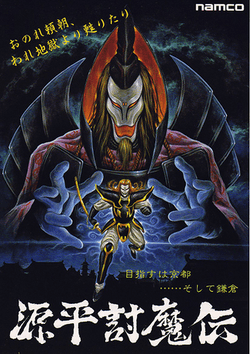Genpei Tōma Den
| Genpei Tōma Den | |
|---|---|
|
Arcade flyer | |
| Developer(s) |
Namco Dempa |
| Publisher(s) |
|
| Platform(s) | Arcade, Family Computer, PC Engine, Wii (Virtual Console), Sharp X68000 |
| Release date(s) |
Arcade
X68000
Family Computer
PC Engine
Mobile Phone
EZweb
Wii Virtual Console
|
| Genre(s) | Beat 'em up |
| Mode(s) | Up to 2 players, alternating turns |
| Cabinet | Upright, cabaret, and cocktail |
| Arcade system | Namco System 86 |
| CPU |
2x Motorola M6809 @ 1.536 MHz, 1x Hitachi HD63701 @ 1.536 MHz |
| Sound |
1x Yamaha YM2151 @ 3.57958 MHz, 1x Namco CUS30 @ 96 kHz, 1x Namco 63701X @ 6 MHz |
| Display | Horizontal orientation, Raster, 288 x 224 resolution |
Genpei Tōma Den (源平討魔伝 Genpei Tōma Den, "The Genji and Heike Tale of the Demon's Demise") is a side-scrolling beat 'em up produced by Namco that was released as a coin-operated video game in 1986 in Japan. It runs on Namco System 86 hardware. Over a decade later, the game was released in America and Europe in the video game compilation Namco Museum Vol. 4 under the title of The Genji and the Heike Clans.
Gameplay
The player makes his way along a Yamato-e painting landscape fighting enemies as they appear. The game offers three types of action: Small Mode (standard), Big Mode (standard, but with large characters and usually boss fights) and Plain Mode (viewed from an overhead perspective). Most stages have torii, which are used to transport the player to a different stage. On most stages featured in Side Mode and Plain Mode, there are multiple torii that can be entered which will lead to different routes on the map. In Big Mode, however, there is only one torii at the end of this type of stage.
The leading character is a historical Japanese samurai, Taira no Kagekiyo (also known as Akushichibyōe Kagekiyo) who fell in the Battle of Dan-no-ura at the end of the Genpei War. In Genpei Tōma Den, he was resurrected and fights Minamoto no Yoshitsune and Saito Musashibo Benkei over the Imperial Regalia of Japan, as well as to defeat his enemy Minamoto no Yoritomo.
The game also features the Sanzu River, a place believed in Japanese Buddhism to separate "the current life" and "the afterlife", resembling the concept of the Underworld or Hell (The river is often compared to the river Styx in Greek mythology). Therefore, some mythological characters like Emma-o (閻魔大王; literally "Enma Dai-o"), god of the Underworld, and the Sun Goddess Amaterasu appear in the game.
Legacy
Ports
The game's first port was released in 1988 for the Japanese Sharp X68000 home computer. Like most arcade games ported to the Sharp X68000, this version of Genpei Tōma Den was nearly identical to the game's arcade counterpart. The game was also ported to the PC Engine (the Japanese TurboGrafx-16) and released on March 16, 1990. The PC Engine version was also released for the Wii's Virtual Console.
Genpei Tōma Den was also featured on the Namco Museum Vol. 4 compilation game for the PlayStation game console, released in 1996 for Japan and 1997 for the U.S. and Europe. For the U.S. and European releases, the game was re-titled as The Genji and the Heike Clans. This would be the first time the original Genpei Tōma Den would make an appearance outside Japan.
Related games
On October 21, 1988, Namco released an interactive board game based on Genpei Tōma Den, which also used a Famicom cartridge for play. This package was titled Genpei Tōma Den: Computer Boardgame.
Genpei Tōma Den: Kan no Ni, a sequel to Genpei Tōma Den, was released on April 7, 1992 exclusively for the PC Engine. Surprisingly enough, this game also had an American release titled Samurai-Ghost for the TurboGrafx-16. This was the only Genpei Tōma Den game released outside Japan before Namco Museum Vol. 4.
Other appearances in media
Kagekiyo has made a few appearances in other video games developed by Namco. He became a featured playable character in the Wonderswan Color game Namco Super Wars. He also appeared as a playable character in the Japan-only RPG titled Namco × Capcom, where he teamed up with Heishirō Mitsurugi from the Soul series and Tarosuke from Yokai Dochuki. In addition, Yoshitsune, Benkei, Yoshinaka and Yoritomo also appeared as bosses. In Tales of Eternia (known as Tales of Destiny II in the U.S.), he appeared in the Aifread's Tomb dungeon, along with Rick Taylor from the Splatterhouse series, to bar the player from advancing through certain doorways. In Tales of Phantasia: Narikiri Dungeon, there is a Kagekiyo costume to be worn. Kagekiyo's armor also appears in the character creation mode of Soulcalibur III, in which it is possible to create a character in his likeness. In Tekken 6, it is possible to customize the character Yoshimitsu in order to make him similar to Kagekiyo. It has recently been announced that the series will be resurrected as a webcomic and part of Namco Bandai's ShiftyLook series, titled Scar. The new webcomic will feature cyborg samurais instead of demons. A remixed version of the game music was included in Ridge Racer V. In Volumen 3, Hobby was playing a Genpei Tōma Den, is one of the Vídeo Games was Adapted for the Crossover Manga titled Hobby's Famicom Seminal (われらホビーズファミコンゼミナール Ware-ra Hobīzu Famikon Zemināru) on 1988 to 1990.
